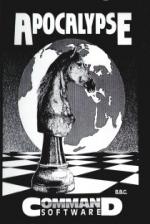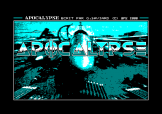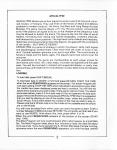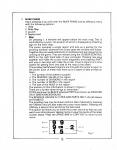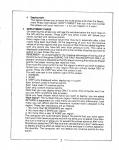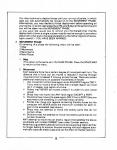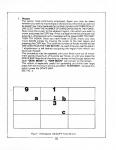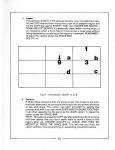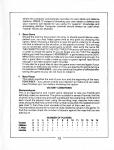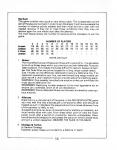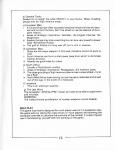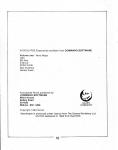Alternative Games Called Apocalypse
| Genre: | Strategy Game: War |
| Publisher: | Command Software |
| Cover Art Language: | English |
| Machine Compatibility: | BBC Model B |
| Release: | Professionally released on Cassette |
| Available For: | Amiga 500, Archimedes A3000, BBC Model B, PlayStation & Spectrum 48K |
| Compatible Emulators: | BeebEm (PC (Windows)) PcBBC (PC (MS-DOS)) Model B Emulator (PC (Windows)) |
| Original Release Date: | 1st September 1987 |
| Original Release Price: | Unknown |
| Market Valuation: | £2.50 (How Is This Calculated?) |
| Item Weight: | 98g |
| Box Type: | Cassette Double Plastic Clear |
| Author(s): | - |
Variant Items
There is 1 other item featuring this same game (that we know about!). Click any of them for their details.
Active Auctions
Closed Auctions
Buy It
Unfortunately no-one is currently selling this item.
Auction Price Watch
Worried you're being ripped off? Closing prices on eBay can help you decide what a reasonable price is for a particular item.

The Micro User
1st September 1987
If you like war games and have plenty of time at your disposal, this game should prove enjoyable. Read Review
Full Instructions
Apocalypse
Apocalypse allows one to four players to enter a world of long and unhurried military campaigns. They use three of the forces of attack and defence available to modern empires: the Army, the Navy and Long Range Nuclear Missiles. The game may be played with only the pre-nuclear, conventional arms if the players can agree to do so, or the shadow of the ubiquitous nuke may be allowed to darken the arena. The players slip into the roles of world leaders, mimicking their daring and foolish escapades, uncertain alliances, and idiosyncratic preoccupations.
The high level tools of deceit and treachery, diplomacy and statesmanship direct the players' struggle with the uncertainty of the lunatic - *but who is he/she*?
Apocalypse is a game of strategy in which the players' skills, both logical and psychological, predominate. Little more than the order of turns is random. Combat between generals is an eye-to-eye affair. The commitment of forces is made and the battle rages. The players have total control over the outcome.
The possibilities of the game are inexhaustible, as each player strives for dominance over cities, rich urban areas, mountain strongholds and the open seas. You will be involved in isolated and supported attacks, in costly invasions and you will tread the thin line between nuclear deterrence and devastation.
Loading
Disk: Hold SHIFT and tap BREAK
Tape: CHAIN"" (RETURN)
After the Credits have been displayed, press any key to continue. You will now be asked which scenario you wish to play. There are six options. Press 1 for saved game (see beow), press 2-5 for a new map or 6 for an expansion kit (see back page).
If this is the first time you have played Apocalypse then it is suggested that you start by playing on one of the smaller maps - either the Levantine or South African. In any event, select the number of the map you wish to play on. Please note that the S. African map is on the A side of the cassette and the others are on the B side.
You will now be asked from which year you want the game to start. Enter a number between 0-9000 then press RETURN. The computer will then ask if you want to use *nukes*. Think about this, then press either Y or N.
When the word "Searching" appears at the bottom of the screen, start the tape.
The Main Program will now load followed, after a short pause, by a brief data file. The Main Program takes about four minutes to load, the data file about thirty seconds. If you have selected the S. African map, keep the tape running, otherwise when the word "Searching" reappears, turn over the tape, rewind and play. When the correct map file has been located, the word "Loading" will appear on the screen. Provided the loading procedure has been followed correctly, the desired map will then be printed after a couple of minutes, together with a gentle reminder of the law of copyright.
Should the program fail to load correctly, rewind the tape a short way and try again. If the program still fails to load, it is advisable to switch off the computer before trying again. It is also a good idea to switch off your computer when you have finished the game since Apocalypse uses the bytes other programs cannot reach!
If loaded correctly, the words "Press Space Bar" are displayed at the bottom of the screen. Stop the tape.
The Map
The maps are divided up into 40 x 20 areas or Regions (20 x 20 for the two half size maps - see below). Your symbols each occupy a single region so you can easily see how large they are. Each region may be one of seven types:
- Sea (blue)
- Agricultural land (green or yellow)
- Industrial (red)
- Mountain (black hatching on green or yellow)
- Desert (black spots on green or yellow)
- City (black square)
- Port (also a black square)
The differences and boundaries between the regions are not easily discernible at first, but is helped considerably by the use of the Scrolling Window (see below).
Upon pressing the Space Bar, you will enter the world of Apocalypse.
Empire Selection
You are the first asked to enter the number of players. This can be any number from 2 to 15 but it is strongly suggested that you should not play with more than six players using one of the half size maps (see below for notes on the different scenarios).
Each player must now enter his/her name (maximum of seven letters) and then choose a symbol. To pick a symbol, press any key when the one you want is on the screen. Symbols that have already been chosen are removed from the list so that they cannot be picked again. From now on, your symbol will be incorporated with your name so that you can always tell which is yours.
The next thing to do is to divide the major power centres amongst yourselves. One by one each player has the chance to 'pick a city' by pressing any key when the one he/she want flashes on the screen. This part of the game has been purposely made difficult so that no player starts the game with too much of an advantage. Note that the first player is picked randomly for the same reason. Note also that some power centres may remain unallocated after the game starts. This is to make sure that each player gets the same number of centres. Each of these 'neutral' cities has one division placed in it and must be attacked and conquered to be entered.
Should the players wish to divide up the cities randomly then simply press any key and hold it down until they have all been dealt out.
Player Turns
The game itself is played in "Turns", each player completing his/her turn befor ethe next player starts. After all players have taken their turns a year has passed and the date is altered.
Each Player Turn is subdivided into four phases:
- Start Turn Phase
- Nuke Phase
- Deployment Phase
- Movement Phase
These phases will now be described in detail below.
1. Start Turn Phase
After the cities have been allocated, press Space Bar to begin the first player's turn.
You will see the name of the first player together with their available revenue points and symbol displayed below the map. To the left of them is a menu with the following options:
- Concede
- Nukes
- Deployment
1. Concede
This option is always available to those unable or unwilling to continue with the fight. You will first be asked to confirm your wishes by answering Y or N, before your symbol is wiped off the face of the map. Remember: all forces belonging to a plyer who concedes *remain* on the map as neutral forces which must be overcome before they can be occupied. If you answer N, you are turned to the menu.
2. Nukes
In this option you may search for nukes that other players have deployed and launch nukes that you previously built. Obviously the first player should ignore this option on the first turn as no nukes can have been deployed. Remember: this is your only chance to launch nukes in this turn.
3. Deployment
This option bypasses the Nuke options. This is your chance to spend your hard-earned revenue points on even more forces of destruction.
2. Nuke Phase
Upon pressing 2 you will enter the Nuke Phase and be offered a menu with the following options:
- Map
- Nuke Map
- Launch
- Deployment
1. Map
On pressing 1, a window will appear below the main map. This is controlled by a cursor, the position of which is displayed by a flashing sign on the main map.
The cursor occupies a single region and acts as a pointer for the scrolling window, wherever the cursor goes the window will follow. Together they are used extensively in all phases and are integral to the running of the game. They are moved using the Cursor Control Keys on the right hand side of your computer. Pressing two keys together will make the cursor move diagonally and pressing SHIFT and one or two keys will make the cursor move five regions at a time (useful for getting from one side of the map to the other).
The window itself shows nine regions at a time with the cursor's region in the centre. Each of these may have up to five types of data printed on them:
- The symbol of the present occupier
- The Revenue Value of the region
- The number of Divisions in the region
- The number of Ships in the region
- The size of the Nuke in the region
The position of this information is shown in figure 1.
There are a further three things to remember.
Cities are shown as Black whereas Ports are shown as Anchors on a green background.
The Revenue Values for Cities and Ports only should always be *doubled*.
The scrolling map may be shown without data if desired by *pressing the TAB key* (this will also make the cursor move faster). *Pressing the TAB key a second time will bring the data back.
This option will allow you to move the cursor around so that you can watch over other players' deployments or view the results of the latest nuclear attack. Press the Space Bar or Copy key to return to the menu.
2. Nuke Map
This option will scan the map for all deployed nukes. When your computer finds one it will produce a high pitched note and flash the offending region. After each complete scan it will produce a low pitched note. This means that if you only get the low note no nukes have been deployed... yet!
3. Launch
If after cold calculation and rejected appeals you choose to launch a nuke then this is the option for you. Move the cursor until it is directly over the nuke you wish to launch, then *press the Copy key*. If, before you do this, you suddenly decide that you don't really want to launch then simply *press the Space Bar* and you will be returned to the main menu.
After pressing the Copy key, and provided that the nuke does belong to you, you will be asked to confirm your judgement in writing - typing anything other than Y or Yes followed by Return will return you to the menu. If however you are still adamant about launching your missile, *the countdown will begin*.
On the count of zero your nuke will launch. It now has to be guided to its target! Remember: you may self destruct the missile during any part of its flight by pressing the Copy key - *but* once it has hit the target, there is nothing you can do to prevent the mass destruction it will cause.
Use the cursor control keys to guide the nuke to its target remembering that if you are not pressing a key when the onboard flight computer requires instruction it will repeat the last one you gave it. When it reaches the target, or if you get lost, *press the Space bar* and the missile will remain at its last position until instructed to do otherwise. There is one small but important point to be made in addition to those above: nukes will only fly as far as their range permits. A nuke's range is dependent on its size so that if you have a size 4 nuke it will fly for approximately four seconds before exploding. You may however gain a little extra flight due to atmospheric conditions in the area.
Blast Damage ... a nuke which hits a target will devastate the area. The blast, radiation cloud and resulting panic and chaos will catastrophically disrupt the military and social structures of the adjacent regions and will activate nuclear missiles in these locations, causing a chain reaction of annihilation.
Divisions and warships within this collateral damage zone will suffer heavy caualties depending on the type of terrain (mountain garrisons will suffer least, forces in cities or ports will be crippled). The revenue values of the area will be severely affected as cities crumble and disease rips through the countryside. This may mean that there is no point in occupying the area you have just nuked - so think carefully before striking.
4. Deployment Phase
On entering this phase you will see the window before the main map on the left and the words: 'Press Copy key when cursor set' below your name, symbol and revenue points.
Every region has a revenue value (this may be 0, especially after a few nukes have been launched). At the beginning of your turn the revenue values of all the regions that you occupy at that time are added together with any points you have left over from previous turns. This value is displayed underneath your name and is the number of points you have to spend on new forces this turn.
Remember: to compensate for the massive advantage of having one of the first turns in the game *during the first round of play only*, all players' revenue is adjusted so that the player moving first receives fewest points, the player moving last receives most.
First move the cursor unti lit is over the region in which you wish to deploy forces (you may deplot in any region that you occupy except SEA regions). *Press the Copy key* when the cursor is set.
You will now see in the bottom right of the screen:
- Division
- Nuke
- Ship (only displayed when deploying in a port)
Each division costs 4 revenue points.
Each nuke costs 12 revenue points.
Each ship costs 8 revenue points.
Note that you may deploy ships *only* in ports, (the computer won't let you put them anywhere else anyway).
Once you have chosen which force you want to deploy, you are asked 'How many?' The number that you type in (which should be followed by RETURN) is dependent on: how many you want to buy (obviously); how many you can afford and the maximum number that is allowed in the region. These last restrictions are as follows:
- No more than 99 divisions per region
- No more than 9 ships per region
- No more than a size 15 Nuke per region
The computer will automatically deduct the points that you have spent from your total revenue points and will not allow you to spend more than this turn's revenue or allow you to exceed the values above at any time. Should you press the Copy key and then decide that you don't really want to deploy anything after all, select any force and type in 0 when asked for the quantity. The computer will not deduct any revenue points for this action.
You may continue to deploy forces until you run out of points, in which case you will automatically be moved on to the Movement Phase. Alternatively, you may decide to finish deployment before spending all your points, in which case press the CTRL and S keys at the same time and you will be taken into the Movement Phase.
At this point, we would like to remind you (for the last time) that the deployment of even a single nuclear missile may be enough to provoke a diplomatic crisis and a maniacal escalation to the nether regions of apocalyptic overkill - *you have been warned*.
4. Movement Phase
On entering this phase the following menu will be seen:
- Map
- Movement
- Save Game
- Next Player
-
Map
This option is the same as in the Nuke Phase. Press the Space Var to return to the menu. -
Movement
Each separate force has a certain degree of movement each turn. The distance that a force can be moved is reduced if moving through mountains but increased if moving across the sea. There are certain additional restrictions on possible movements of forces:
- All movement is from one region to an *adjacent* region *only*. If you wish to move a force further than a single region you must do it in stages, one region at a time.
- Nukes may *never* be moved unless it is under its own rocker power.
- Ships may not move into *any* land region *except* a Port.
- Divisions may move into a sea region *only* from a Port (they are assumed to be travelling in unarmed troop carriers).
- Forces may move into regions containing friendly forces but the computer will *never* allow the maximum numbers for each region to be exceeded (see above)
- Ships may not attempt to move into enemy ports that do not contain ships.
- Divisions may not attempt to move into enemy ports that do not contain divisions.
Any attempt to move into an enemy region that satisfies the above conditions will initiate Combat (see under Combat section).
Note that unguarded nukes do not count as occupying a region as they no longer belong to anyone. Anyone moving into such regions automatically captures these nukes and can fire them on his/her next turn.
Moving
To move a force/s, position the cursor over it/them, then press the Copy key. A list with up to four options will be displayed (just how many options are given depends on the types of forces occupying the region):
- Move
- Occupy
- Leave
- Convoy
1. Move
The most basic of the movement options. You may first be asked whether you wish to move ships or divisions (provided that both forces are present in the region), followed by the number you want to move (type in the number then press Return - don't worry about hitting the cursor keys accidentally, the computer will deal with that). When you have done this, move the cursor to the adjacent region, into which you wish to move your force/s and press the Copy key. If this is a legal move, the computer will execute it, otherwise you have to start again.
This option is a One-Step option, i.e. to move a force 5 regions, for example, you must repeat the whole process five times. This option is useful for splitting large forces, thus optimising the number of units moved. The other options are more useful for moving large distances. See Fig 2.
2. Occupy
The option most commonly employed. Again you may be asked whether you wish to move ships or divisions but this time you will not be asked how many because the number moved is *automatically one less than the number of ships/divisions in the force*. Now move the cursor to the adjacent region, into which you wish to move, and press the Copy key. If this is a legal move the computer will execute it, otherwise an error message will be issued *and you may then try again*.
Once you have made a legal move, you may move *again* simply by moving the cursor to the next region and pressing the Copy key. This time the number of forces moved willb e *one less than the time before*, (i.e. each time you use this option one ship/division is left behind occupying the region from which you have just moved).
This procedure may be repeated until your force runs out of movement points (maximum of five points per force) or until you press the Space Bar. Note that all the time you remain in the Occupy option the label "DIVN. MOVE" or "SHIP MOVE" will remain on the screen.
This option is especially useful for spreading out thinly over large areas with the minimum of time and effort. Remember: to leave this option, press the Space Bar.
3. Leave
This option is exactly the same as Occupy (you must set the cursor, hit the Copy key and then move the cursor to an adjacent region and hit the Copy key again) *except that all forces are moved - none are left behind*. It is especially useful when moving ships, or on occasions when a force has to move across a large area without being depleted by occupying all the regions in between. Remember: to leave this option, press the Space Bar.
4. Convoy
If ships attack divisions that are alone at sea, the divisions are automatically destroyed, so obviously the thing to do is to protect divisions at sea with ships. This option has been provided for exatly that purpose and with it you can move ships and divisions together. In all other respects it is the same as the Leave option. To leave this option, press the Space Bar.
Note: Should you press the Copy key after selecting a force to move and then decide that you don't really want to move a force in this region after all, *choose Occupy (or Leave) and then immediately press the Space Bar. This will exit you from the option without moving anything or expending movement points.
Combat
Combat is initiated when any force attempts to make a legal move into a region occupied by an enemy force. Remember: Divisions may only attack divisions and ships may only attack ships, except unescorted divisions at sea, see below.
Either DIVN.ATTACK or SHP.ATTACK will appear on the right hand side of the screen (depending on the type of attacking force) and underneath will be a list of the options. The exact number and range of this list will depend on two things.
- The size of the attacking force. The size of the defending force only effects the number of times it will have to be attacked in order to destroy it.
- The type of terrain in the defender's region (cities, urban areas and mountain ranges are difficult to attack; open land or sea is much easier).
Select the type of attack to be made, then press the corresponding number. The higher the number, the more aggressive the type of attack. It is important that the defender does not see your choice.
The defender must now attempt to counter this attack by selecting from a similar list.
If they choose exactly the correct defence (i.e. the same number) then they win the battle and casualties equal to the number chosen are inflicted on the attacker. If the defender underestimates the attack then they will lose casualties equal to the number the attacker chose. The closer the number the defender chooses to the attackers the more casualties the attacker will suffer in achieving victory. Should the defender completely overestimate the attack then he will lose and inflict no casualties on the attacker.
Remember: combat will always reduce the movement allowance for this turn.
If after combat the defender is completely destroyed then attacking forces will be moved into the region automatically. However, if the defender still has forces left in the region then they will have to be attacked again. Providing that the attacker has adequate forces with enough movement left to do so. This is achieved by repeating the movement operation that brought the force into conflict originally.
Combat Variation
Invasions - If divisions attack from sea on to land (even if it is a port) then their job is made harder by allowing the defender a second choice if the first fails.
Unescorted Divisions - As has been previously stated, divisions that are unescorted and at sea will be completely destroyed if attacked by enemy ships (this is not combat but genocide).
Convoys - Attacking with a convoy movement option may initiate both ship and division combat if attacking a port.
Computer override - Both players may enter the world of future combat where the computer automatically launches its own attack and defence systems. Press 0 instead of choosing your own attack or defence and your machine will decide for you using its 'superior' knowledge and processing abilities. Computer override should always be used when 'neutral' forces are attacked.
3. Save Game
Should the evening have grown too long, or should events take an unexpected turn, you may freeze game time at this point by choosing this option. When choosing a filename to save the game under try to choose one that is relevant to the situation, or the players involved. This will help you to remember which saved game is which. Also write the name *on the cassette exactly as you typed it in" as you will have to know it in order to reload the game (if you do forget you can *CAT the cassette before you load the program).
Remember: a game takes around *eight minutes* to save (or load) so make sure you have a tape long enough. It is also a good idea to save the same every now and again if your house has an electricity slot meter or if you are playing the game during a thunderstorm! Remember: you may continue the game unaffected after saving the game as you do not have to reload it.
4. Next Player
This option signifies the end of your turn and the beginning of the next. Remember: you cannot reverse your decision so make sure you really have finished your turn before choosing this option.
Victory Conditions
Nocopocalypse
This is an aggressive and violent game designed to lose you friends and definitely make you enemies. The game is played in a series of rounds, the first of which is four years long and each subsequent two years long. At the end of each tound the players must, using the scrolling map, discover how many cities and ports that they control if this number is less than the needed amont (see chart 1) then they must concede at the start of their next turn.
The chart below shows the number of cities needed to remain in the game. To find this number check the number of players against the map that you are playing on.
Number Of Players
| 2 | 3 | 4 | 5 | 6 | 7 | 8 | 9 | 10 | 11 | 12 | 13 | 14 | 15 | |
| European | 28 | 19 | 14 | 11 | 9 | 8 | 7 | 6 | 5 | 5 | 5 | 4 | 4 | 4 |
| Caribbean | 24 | 16 | 12 | 8 | 7 | 6 | 6 | 5 | 5 | 4 | 4 | 4 | 3 | 3 |
| S. African | 18 | 11 | 9 | 7 | 5 | - | - | - | - | - | - | - | - | - |
| Levantine | 16 | 10 | 8 | 6 | 4 | - | - | - | - | - | - | - | - | - |
Big Buck
This game is either very quick or very slow to play. This is dependent on the skill of the players involved. In order to win, the player must have exceeded the number of revenue points needed and then must survive a year with the needed revenue. If they fail to meet these conditions ten they may not declare again for one whole year after the attempt.
The chart below show the number of revenue points necessary to win the game.
Number Of Players
| 2 | 3 | 4 | 5 | 6 | 7 | 8 | 9 | 10 | 11 | 12 | 13 | 14 | 15 | |
| European | 1035 | 690 | 520 | 415 | 345 | 300 | 260 | 230 | 210 | 190 | 175 | 160 | 150 | 140 |
| Caribbean | 920 | 615 | 460 | 370 | 310 | 265 | 230 | 205 | 185 | 170 | 155 | 145 | 135 | 125 |
| S. African | 580 | 385 | 290 | 230 | 195 | - | - | - | - | - | - | - | - | - |
| Levantine | 315 | 210 | 160 | 125 | 105 | - | - | - | - | - | - | - | - | - |
Hints On Play
1. Nukes!
The most effective size of Nukes are those with a value of 3+. It is advisable to build up Nukes deep within your territory and well defended. Ports are ideal locations. This makes the Nukes difficult to capture. Always remember that Nuke Silos are prime targets for a long range nuclear attack. Size 1 Nukes can be effectively deployed to secure a defensive line. If an opponent overwhelms your line, one well-aimed long range missile can soon set off a chain reaction that can provide welcome breathing space.
Warning: One sneakily launched pre-emptive strike can annihilate the most secure defensive line.
Remember: Deploying nuclear weapons is the most aggressive act an empire can understake, short of all out devastation.
Remember: Poorly defended Nukes can be easily annexed by unscrupulous empires.
2. Alliances
Diplomacy is a vital element of the game. In the Nocopocalypse game you may well find that alliances are a temporarily affair and should be treated as such. In Big Buck the players should only break alliances if one of the partners is likely to win.
A powerful empire can be an immense force for stability or instability, but must handle allies with care. From these allies' point of view the major power could, after a period of uncertainty, become unstoppable; therefore allies should always try and assess the optimum time to break away and join a united opposition. *Beware the nuke in the back!*
3. Strategy & Tactics
-
General Strategy
Establish power bases surrounded by a defence in depth. -
General Tactic
Always try to weight the odds heavily in your favour. When invading, always aim for high revenue areas. -
European Map
i) it is surprising how often successful empires follow the lines of historical and current frontiers. Don't be afraid to use the lessons of European History.
ii) Areas of strategic importance: Gibraltar; the English Channel; the Skagerrack.
iii) Eastern Europe may look unexciting but can be a very powerful power base: Remember Russia.
iv) The gulf of Arabia is a long way off, but is rich in revenue. -
Caribbean Map
i) Ships are the major weapon in this area, therefore control of ports is vital.
ii) South America can form a vital power base from which to dominate Central America.
iii) Islands are good sites for nukes. -
South Africa
i) Usually a North/South conflict.
ii) Areas of strategic importance: Madagascar, the northern ports.
iii) The close grouping of high revenue cities invites nuclear attack - try to be a Boar.
iv) North West Africa looks boring, but can be easily defended and is well out of the way in the event of a holocaust. -
Levantine
i) This is an unknown quantity. -
The Last Word
The successful "Apocalype" player will need to be able to experiment and innovate.
Warning: The indiscriminate proliferation of nuclear weapons courts disaster.
Solo Play
This game is primarily designed for multi-player use but it is possible to play the game solo by taking the roles of two or more players and allowing the computer-override to calculate the outcome of the combat. It is also of great use in familiarising yourself with the working of the game.
Advertisement
Apocalypse Expansions available from Command Software
Volume One: Nova Maps
USA
SE Asia
S Africa
Arctic Circle
Star Systems
Nether Earth
Game Credits
Apocalypse is produced under licence from The Games Workshop Ltd, and first appeared in 1983 from Red Shift
Screen Designers
The following utilities are also available to allow you to edit the supplied screens of this game:
Cheats
Download
A digital version of this item can be downloaded right here at Everygamegoing (All our downloads are in .zip format).
| Download | What It Contains |
|---|---|
| A digital version of Apocalypse suitable for BeebEm (PC (Windows)), PcBBC (PC (MS-DOS)), Model B Emulator (PC (Windows)) |
Report A Problem
We thank you from the bottom of our hearts if you report something wrong on our site. It's the only way we can fix any problems!
You are not currently logged in so your report will be anonymous.
Add Note
Release Country
Change the country to update it. Click outside of this pop-up to cancel.

